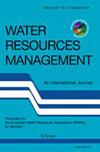Leveraging Transfer Learning in LSTM Neural Networks for Data-Efficient Burst Detection in Water Distribution Systems
IF 4.7
3区 环境科学与生态学
Q1 ENGINEERING, CIVIL
引用次数: 0
Abstract
Abstract Researchers and engineers employ machine learning (ML) tools to detect pipe bursts and prevent significant non-revenue water losses in water distribution systems (WDS). Nonetheless, many approaches developed so far consider a fixed number of sensors, which requires the ML model redevelopment and collection of sufficient data with the new sensor configuration for training. To overcome these issues, this study presents a novel approach based on Long Short-Term Memory neural networks (NNs) that leverages transfer learning to manage a varying number of sensors and retain good detection performance with limited training data. The proposed detection model first learns to reproduce the normal behavior of the system on a dataset obtained in burst-free conditions. The training process involves predicting flow and pressure one-time step ahead using historical data and time-related features as inputs. During testing, a post-prediction step flags potential bursts based on the comparison between the observations and model predictions using a time-varied error threshold. When adding new sensors, we implement transfer learning by replicating the weights of existing channels and then fine-tune the augmented NN. We evaluate the robustness of the methodology on simulated fire hydrant bursts and real-bursts in 10 district metered areas (DMAs) of the UK. For real bursts, we perform a sensitivity analysis to understand the impact of data resolution and error threshold on burst detection performance. The results obtained demonstrate that this ML-based methodology can achieve Precision of up to 98.1% in real-life settings and can identify bursts, even in data scarce conditions.利用LSTM神经网络中的迁移学习实现配水系统的数据高效突发检测
研究人员和工程师使用机器学习(ML)工具来检测管道爆裂并防止供水系统(WDS)中的重大非收入水损失。尽管如此,迄今为止开发的许多方法都考虑了固定数量的传感器,这需要重新开发ML模型并收集足够的数据,并使用新的传感器配置进行训练。为了克服这些问题,本研究提出了一种基于长短期记忆神经网络(NNs)的新方法,该方法利用迁移学习来管理不同数量的传感器,并在有限的训练数据下保持良好的检测性能。提出的检测模型首先学习在无突发条件下获得的数据集上再现系统的正常行为。训练过程包括使用历史数据和时间相关特征作为输入,提前一步预测流量和压力。在测试过程中,基于使用时变误差阈值的观测值和模型预测之间的比较,后预测步骤标记潜在的爆发。当增加新的传感器时,我们通过复制现有通道的权重来实现迁移学习,然后对增强的神经网络进行微调。我们评估了该方法的鲁棒性在模拟消火栓爆发和真实爆发在10区计量区域(dma)的英国。对于真实的突发,我们进行了灵敏度分析,以了解数据分辨率和错误阈值对突发检测性能的影响。结果表明,这种基于ml的方法在实际环境中可以达到高达98.1%的精度,即使在数据稀缺的条件下也可以识别突发。
本文章由计算机程序翻译,如有差异,请以英文原文为准。
求助全文
约1分钟内获得全文
求助全文
来源期刊

Water Resources Management
环境科学-工程:土木
CiteScore
7.40
自引率
16.30%
发文量
332
审稿时长
9 months
期刊介绍:
Water Resources Management is an international, multidisciplinary forum for the publication of original contributions and the exchange of knowledge and experience on the management of water resources. In particular, the journal publishes contributions on water resources assessment, development, conservation and control, emphasizing policies and strategies. Contributions examine planning and design of water resource systems, and
operation, maintenance and administration of water resource systems.
Coverage extends to these closely related topics: water demand and consumption; applied surface and groundwater hydrology; water management techniques; simulation and modelling of water resource systems; forecasting and control of quantity and quality of water; economic and social aspects of water use; legislation and water resources protection.
Water Resources Management is supported scientifically by the European Water Resources Association, a scientific and technical nonprofit-making European association.
 求助内容:
求助内容: 应助结果提醒方式:
应助结果提醒方式:


